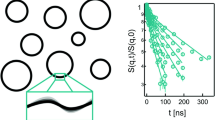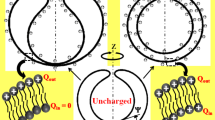Abstract
Vesicles are closed surfaces of bilayer membranes. Their mean shapes and fluctuations are governed by the competition of curvature energy and geometrical constraints on the enclosed volume and total surface area. A scheme to calculate these fluctuations to lowest order in the ratio of temperature to bending rigidity is developed. It is shown that for fluctuations that break a symmetry of the mean shape the area constraint indeed acts like a tension whose value is given by the Lagrange multiplier used to enforce the area constraint in the first place. As a consequence, these fluctuations are also insensitive to the specific variants of the curvature model. For fluctuations that preserve the symmetry of the mean shape the role of the area constraint is more subtle. The low temperature expansion breaks down in the spherical limit where with the excess area another small parameter enters. By incorporating the area constraint in this limit exactly, the validity of the conventional approach using an effective tension for fluctuations of quasi-spherical vesicles can be assessed.
Similar content being viewed by others
References
For reviews, see (a) R. Lipowsky, Nature349, 475 (1991);
M. Wortis, U. Seifert, K. Berndl, B. Fourcade, L. Miao, M. Rao, and R. Zia, inDynamical phenomena at interfaces, surfaces and membranes, edited by D. Beysens, N. Boccara, and G. Forgacs (Nova Science, New York, 1993), pp. 221–236
U. Seifert and R. Lipowsky, in Handbook of Physics of Biological Systems, vol. 1, edited by R. Lipowsky and E. Sackmann (Elsevier, Amsterdam 1994).
P. Canham, J. Theoret. Biol.26, 61 (1970).
W. Helfrich, Z. Naturforsch.28c, 693 (1973).
E. Evans, Biophys. J.14, 923 (1974).
H. Deuling and W. Helfrich, J. Physique37, 1335 (1976).
S. Svetina and B. Zeks, Eur. Biophys. J.17, 101 (1989)
U. Seifert, K. Berndl, and R. Lipowsky, Phys. Rev. A44, 1182 (1991).
L. Miao, B. Fourcade, M. Rao, M. Wortis, and R. Zia, Phys. Rev. A43, 6843 (1991).
K. Berndl, J. Käs, R. Lipowsky, E. Sackmann, and U. Seifert, Europhys. Lett.13, 659 (1990).
W. Helfrich and R.-M. Servuss, Il Nuovo Cimento3D, 137 (1984).
S. Milner and S. Safran, Phys. Rev. A36, 4371 (1987).
E. Evans and W. Rawicz, Phys. Rev. Lett.64, 2094 (1990).
F. David and S. Leibler, J. Phys. II France1, 959 (1991).
M. Schneider, J. Jenkins, and W. Webb, J. Phys.45, 1457 (1984).
H. Engelhardt, H. Duwe, and E. Sackmann, J. Physique Lett.46, L395 (1985)
I. Bivas, P. Hanusse, P. Bothorel, J. Lalanne, and O. Aguerre-Chariol, J. Phys.48, 855 (1987).
J. Faucon, M. Mitov, P. Meleard, I. Bivas, and P. Bothorel, J. Phys. France50, 2389 (1989).
H. Duwe, J. Käs, and E. Sackmann, J. Phys. France51, 945 (1990).
P. Meleard, J. Faucon, M. Mitov, and P. Bothorel, Europhys. Lett.19, 267 (1992).
M. Peterson, J. Math. Phys.26, 711 (1985).
M. Peterson, J. Appl. Phys.57, 1739 (1985).
M. Peterson, Mol. Cryst. Liq. Cryst.127, 159 (1985).
M. Peterson, H. Strey, and E. Sackmann, J. Phys. II France2, 1273 (1992).
M. Peterson, Phys. Rev. A45, 4116 (1992).
E. Evans, Biophys. J.30, 265 (1980).
S. Svetina and B. Zeks, Biochemica et Biophysica Acta42, 86 (1983).
U. Seifert, L. Miao, H.-G. Döbereiner, and M. Wortis, inThe Structure and Conformation of Amphiphilic Membranes, Vol. 66 ofSpringer Proceedings in Physics, edited by R. Lipowsky, D. Richter, and K. Kremer (Springer, Berlin, 1991), pp. 93–96.
W. Wiese, W. Harbich, and W. Helfrich, J. Phys.: Cond. Matter4, 1647 (1992).
B. Bozic, S. Svetina, B. Zeks, and R. Waugh, Biophys. J.61, 963 (1992).
L. Miao, U. Seifert, M. Wortis, and H.-G. Döbereiner, Phys. Rev. E49, 5389 (1994).
R. Waugh, J. Song, S. Svetina, and B. Zeks, Biophys. J.61, 974 (1992).
A. Yeung, Ph.D. thesis, University of British Columbia, 1994.
M. Nikolic, U. Seifert, and M. Wortis, in preparation.
M. Peterson, Phys. Rev. A39, 2643 (1989).
W. Helfrich, J. Physique47, 321 (1986).
Z.-C. Ou-Yang and W. Helfrich, Phys. Rev. A39, 5280 (1989).
I. Bivas, L. Bivolarski, M. Mitov, and A. Derzhanski, J. Phys. II12, 1423 (1992).
W. Helfrich, J. Physique48, 285 (1987).
P. Nelson and T. Powers, J. Phys. II France3, 1535 (1993).
W. Cai, T. Lubensky, P. Nelson, and T. Powers, J. Phys. II France4, 931 (1994).
D. Morse and S. Milner, Europhys. Lett.26, 565 (1994).
D. Morse and S. Milner, Statistical Mechanics of Finite Fluid Membranes, preprint, 1994.
I thank D. Morse, T. Lubensky and P. Nelson for illuminating discussions on the Liouville factor.
Author information
Authors and Affiliations
Additional information
Dedicated to Prof. Herbert Wagner on the occasion of his 60th birthday




